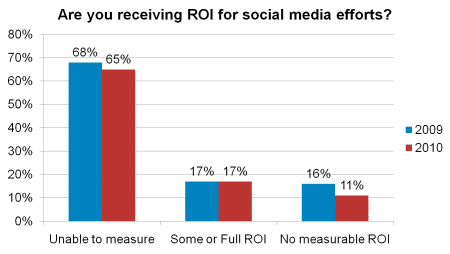John Ragsdale is vice president of technology research for the Technology Services Industry Association. Ragsdale spoke with Francoise Tourniaire, a long-time Technology Services Industry Association partner and founder of FT Works, a consulting firm that helps technology companies create and improve support operations. Tourniaire spoke about the value service businesses can get from social media efforts. Republished with permission from Ragsdale’s Eye on Service.
 John Ragsdale: Talk about jumping into the lion’s den of the ROI of customer communities — this is the hottest topic in support today. About three fourths of TSIA members companies offer a customer community. Does it surprise you that so many companies adopted this technology without an understanding of where the ROI comes from — or if there is ROI?
John Ragsdale: Talk about jumping into the lion’s den of the ROI of customer communities — this is the hottest topic in support today. About three fourths of TSIA members companies offer a customer community. Does it surprise you that so many companies adopted this technology without an understanding of where the ROI comes from — or if there is ROI?
Francoise Tourniaire: The rational side of me hates jumping into any large initiative without a good metrics strategy – but at the same time experiments are wonderful and mind-opening. Support organizations tend to be very conservative so it’s great to see them taking risks. My view is that it’s always ok to try something new, and that part of the experiment must be to measure the success of the experiment. So sure, get going without being certain you will see an ROI, but take steps to measure the ROI.
Ragsdale: According to our most recent social media survey, 65 percent of TSIA members active in social media say they are unable to measure ROI — they don’t know how or where to start. Many companies assumed they would easily deflect phone calls to the forum, but I don’t hear many stories out there of dropping call volumes. What are some of the financial benefits other than call deflection?

2010 TSIA social media survey
Tourniaire: In my experience, the bulk of the quantifiable savings comes from case deflection so it would be interesting to see why volumes are not affected. At the same time, I see lots of my clients experiencing significant benefits on the knowledge management side. Rather than having to invest large amounts of resources in creating and maintaining knowledge, they find that the forums create a strong “tribal” knowledge base, which can be even more useful to customers than something built internally. So that would be one area to investigate. Another area is how increased customer satisfaction (and customers are overwhelmingly happy with forums) can translate into repeat purchases, additional purchases and referrals. It’s not easy to track them, but it’s worth trying.
Ragsdale: One of the complaints I’ve had from members is the reporting tools for their community platform are insufficient, and there aren’t enough prepackaged reports to get them started. In the workshop, do you make recommendations on what ‘best practice’ reports companies should be tracking?
Tourniaire: Reporting is an issue, yes. Some of the problem lies with what the limitations of what community vendors offer today, but a big part of the problem is that support communities are often rolled out without much forethought and without solid thinking around metrics. If you think through the metrics requirements and implement with them in mind, you can gather those “best practices” metrics much more easily.
Ragsdale: Let’s talk about integration. Francoise, I believe you were at Scopus about the same time I was at Clarify, so we both have a CRM-centric background. I have to say I am saddened that only 8 percentof our members have integrated communities to CRM — and that number remained flat from the 2009 survey! Clearly, CRM integration isn’t a priority, but in my mind, it should be. Does the 360-degree view of the customer not include community activity? Or is CRM no longer the center of the customer data universe?
Tourniaire: Fifteen years ago when Scopus was pushing the 360-degree view of the customer I totally, absolutely believed that we would deliver just that to all our customers. But even then I could not help but notice that even our customers were not always purchasing an entire solution from us, and with the proliferation of functionality I think things may be worse today than they were at the time. With communities, integration is rare because many times communities were started as a skunkworks project, under the radar of the structured and slow-moving CRM team. So it will take time to hook up all of the pieces. I’m very hopeful in the long term.
Ragsdale: Could you provide me background on your course, “A Goldmine? Calculating the ROI of Customer Communities,”? [Monday, May 2, at TSIA Spring in Santa Clara, CA]
Tourniaire: It’s going to be very hands-on, with the goal that every attendee takes away a custom model for his or her organization, so it will run as a hands-on workshop. We’ll start with some best practices discussions on ROI in general, and then we will dive into practical topics, from measuring case deflection to estimating knowledge management savings, drawing on my experience working with a variety of clients on community ROI. The workshop will be very attendee-driven. Ideally I’d like to be able to put the power of the attendees of the workshop behind each and every ROI we build. That’s the power of communities! I’m all about practical, tangible results.

Share this: